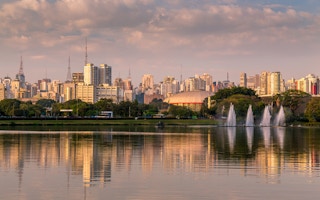NEW YORK – By the end of this century, ten billion people will inhabit our planet, with 8.5 billion living in cities. This could be the stuff of nightmares. But, with sufficient political will, vision, and creativity – along with some simple, practical policy changes – we may be able to create cities of dreams.
Cities are hubs of economic and social power. They drive national and global development by concentrating skills, ideas, and resources in a single location. But rapid urban development comes at a heavy cost. As cities expand, they swallow up land that would otherwise be used for food production. They drain water supplies, account for almost 70 per cent of global energy use, and generate more than 70 per cent of greenhouse-gas emissions.
If global growth is to be sustainable and equitable, we will need to alter the balance between rapid urbanization and the unrelenting consumption of resources that it fuels. This is a main goal of the UN Conference on Sustainable Development, which has warned of the unprecedented pressures that economic growth will impose in coming decades on infrastructure (especially transportation), housing, waste disposal (especially of hazardous substances), and energy supplies.
The battle to keep the world’s cities – and thus the global economy – both dynamic and sustainable can be won by developing innovative ways to consume our limited resources, without diminishing them or degrading the delicate ecological systems on which they depend. To achieve this, the world must meet six broad challenges.
“
With almost 30 per cent of city dwellers in the Asia-Pacific region living in slums, one of our greatest tests will be to improve their living conditions without wreaking havoc on the environment
First, we must change the way we design cities. Sustainability must be central to all urban planning, particularly in coastal cities that will soon face the ravaging effects of climate change. Denser cities use land more efficiently, reduce the need for private cars, and increase the quality of life by making space for parks and nature. Likewise, tightly integrated mass-transit systems reduce greenhouse-gas emissions dramatically.
Second, we must rethink how we design and operate buildings so that they use less energy – or, better still, generate energy. Buildings are responsible for substantial CO2 emissions, owing to the materials used in their construction, their cooling and heating requirements, and auxiliary functions such as water supply, wastewater, and solid-waste disposal. Our building codes need to promote energy-efficient engineering and construction technologies, which can be supported by tax incentives and stricter regulations. With almost 30 per cent of city dwellers in the Asia-Pacific region living in slums, one of our greatest tests will be to improve their living conditions without wreaking havoc on the environment.
The third challenge is to alter citizens’ transport habits. This means shifting from private cars to public transportation, and from road to rail. Indeed, wherever possible, we should try to reduce the need to travel at all. Transport systems that favor cars and trucks cause accidents, pollution, and chronic congestion. Moreover, the transport sector accounted for 23 per cent of all energy-related CO2 emissions in 2004, and it is the fastest growing source of emissions in developing countries. Instead, we need to integrate transportation, housing, and land use, encourage reliance on public transportation, and make our streets pleasant and safe for walking (especially for women and the disabled).
The fourth challenge is to change how we produce, transport, and consume energy. This includes creating more efficient energy systems and increasing our investment in renewable sources (which will, one hopes, create jobs in the process). We can also encourage households to consume less energy, and companies to reduce the amount of energy that they waste.
Fifth, we must reform how we manage water resources and water infrastructure, so that this precious resource can be re-used several times, and on a city-wide scale. This requires us to integrate the various aspects of water management, such as household supply, rainwater harvesting, wastewater treatment and recycling, and flood-control measures.
Finally, we must change the way we manage solid waste so that it becomes a resource, not a cost. In many developing countries, 60 to 80 per cent of solid waste is organic, with open dumping causing excessive amounts of methane to enter the atmosphere. Cash-strapped local governments spend 30 to 40 per cent of their budgets on waste management but derive little in return. Yet, with some simple technological and design improvements – aimed, for example, at achieving higher rates of composting and recycling – 90 per cent of this waste could be converted into something useful, such as biogas and resource-derived fuel.
These six steps require a comprehensive and coordinated change in behavior, and will require government at all levels to cooperate, invest at scale, share ideas, replicate best practices, and plan for the long term. It is a monumental and daunting challenge, but not an impossible one. If it can be achieved, the world may yet get the urban future that it deserves.
Noeleen Heyzer is Under-Secretary-General of the United Nations and Executive Secretary of the Economic and Social Commission for Asia and the Pacific. This post originally appeared in Project Syndicate.

















